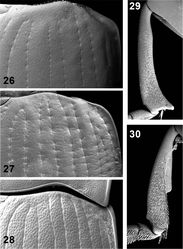Monodius lamottei
| Notice: | This page is derived from the original publication listed below, whose author(s) should always be credited. Further contributors may edit and improve the content of this page and, consequently, need to be credited as well (see page history). Any assessment of factual correctness requires a careful review of the original article as well as of subsequent contributions.
If you are uncertain whether your planned contribution is correct or not, we suggest that you use the associated discussion page instead of editing the page directly. This page should be cited as follows (rationale):
Citation formats to copy and paste
BibTeX: @article{Kamiński2014ZooKeys415, RIS/ Endnote: TY - JOUR Wikipedia/ Citizendium: <ref name="Kamiński2014ZooKeys415">{{Citation See also the citation download page at the journal. |
Ordo: Coleoptera
Familia: Tenebrionidae
Genus: Monodius
Name
Monodius lamottei (Gridelli, 1954) comb. n. – Wikispecies link – ZooBank link – Pensoft Profile
- Selinus lamottei Gridelli, 1954: 127.
- Ectateus lamottei (Gridelli, 1954). – Ardoin 1963[1]: 222; Iwan 2002b[2]: 266.
Studied material
Holotype, male (MNHN): “Muséum Paris, Nimba (Guinée), M. Lamotte II. VI. 42”, “Typus”, “Keoulenta”; Paratypes, male and female (MNHN): same data as holotype. Other material: 3 females (MNHN): “Muséum Paris, Côte d’Ivoire, Réserve du Banco, R. Paulian & C. Delamare”, 2 males and 2 females (MNHN): “Coll Mus. Tervuren, Côte d’Ivoire: Bingervillie, X.1961, J. Decelle”, “Muséum Paris Coll. P. Ardoin, 1978”, female (MRAC): “Coll Mus. Tervuren, Côte d’Ivoire: Korea, S. de Daloa, J. Decelle, VII / IX.1962”, “Ectateus laevistriatus, det. Ardoin 1965”, female (MRAC): “Coll Mus. Tervuren, Côte d’Ivoire: Adlapoté, 80 km. W. Abidjan, J. Decelle, II-1962”, “Ectateus laevistriatus, det. Ardoin 1965”, males (TMNH): “Adiopodoumé, B. Côte d’Ivoire, Ledoux”, female (MNHN): “Côte d’Ivoire”, “Muséum Paris Coll. P. Ardoin, 1978”.
Redescription
Habitus as in Fig. 54. Body length = 12.0–14.5 mm. Elytra wider and longer than pronotum (width ratio elytra / pronotum = 1.1–1.2; length ratio elytra / the middle of pronotum = 2.2–2.4).
Dorsal side of head dull, with fine punctures (the intervals between the punctures are smaller than the diameter of the puncture). Frontoclypeal suture fine. Clypeal emargination relatively shallow (clypeal emargination width / depth ratio = 10.0–11.5). Mentum with median part wide. Submentum with short base. Maxillary palp not widened (width of maxillary palp / length of 3rd antennomere = 1.1–1.2). Length of antennae greater than pronotal length (ratio antenna / pronotum from tip of anterior pronotal angle to tip of posterior pronotal angle = 1.2–1.3). 3rd antennomere relatively long (length ratio of antennomere 3rd / 2nd = 2.8–2.9).
Pronotal disc transverse (middle of pronotum length / width ratio = 0.5–0.6), dull, with fine punctures (the intervals between the punctures are smaller than the diameter of the puncture). Anterior pronotal angles sharp and strongly protruding towards front. Lateral margins of pronotal disc rounded. Apophyseal and basal depressions on pronotal disc present; apophyseal depressions trapezoidal. Pronotal hypomera dull; without punctures.
Elytra oblong (elytra length / width ratio = 1.1–1.2). Elytral striae with fine punctures, impressed on the whole length. Elytral intervals shiny, non-convex, with coarse punctures (the intervals between the punctures are smaller than the diameter of the puncture). Elytral base slightly sinusoidal. Elytral humeri rounded, not protruding laterad. Wings absent. Scutellum rounded.
Intercoxal process protruding towards mesoventrite. Metaventrite reduced (length ratio cavity of hind coxa / metaventrite between the insertions of mid and hind coxae ca. 2). In both sexes abdominal process without tubercles, relatively narrow (process of 1st abdominal ventrite / process of metaventrite = 2.1–2.3). 5th abdominal ventrite without bordering; punctures fine (the intervals between the punctures are greater than the 2 diameters of the puncture).
Male legs. Protarsi slightly widened. Protibiae as in Monodius convexipennis. Mesotibiae with a small denticle at the apex. Metafemorae with an hair fringe. Female legs. Protarsi slightly widened. Other leg parts simple.
Male genitalia. Parameres extended towards apex; length equal to the 0.5 of the rest of aedeagal tegmen (Fig. 18). Clavae straight (Fig. 18). Female genitalia. Paraproct equal to coxites. Bursa copulatrix with two sacs. Spermatheca with narrow ducts.
Distribution
This species has been collected in the following ecoregions of West Africa (Ivory Coast, Republic of Liberia): Eastern Guinean forests, Western Guinean lowland forests (Fig. 42).
Taxon Treatment
- Kamiński, M; 2014: A cladistically based reinterpretation of the taxonomy of two Afrotropical tenebrionid genera Ectateus Koch, 1956 and Selinus Mulsant & Rey, 1853 (Coleoptera, Tenebrionidae, Platynotina) ZooKeys, 415: 81-132. doi
Images
|
Other References
- ↑ Ardoin P (1963) La réserve naturelle intégrale du Mont Nimba. III. Coleoptera Tenebrionidae. Mémoires de l’Institut Français d’Afrique Noire 66: 221–267.
- ↑ Iwan D (2002b) Catalogue of the World Platynotini (Coleoptera: Tenebrionidae). Genus 13: 219–323.
- ↑ Olson D, Dinerstein E, Wikramanayake E, Burgess N, Powell G, Underwood E, D’Amico J, Itoua I, Strand H, Morrison J, Loucks C, Allnutt T, Ricketts T, Kura Y, Lamoreux J, Wettengel W, Hedao P, Kassem K (2001) Terrestrial Ecoregions of the World: A new map of life on Earth (PDF, 1.1M). BioScience 51: 933–938. doi: 10.1641/0006-3568(2001)051[0933:TEOTWA]2.0.CO;2


![Figure 42. Distribution of the species of Monodius convexipennis, Monodius gravis, Monodius laevistriatus, Monodius lamottei and Eleoselinus gen. n. The division of Afrotropical Realm into ecoregions was adopted after Olson et al. 2001[3]. Different colors were used to distinguish the adjacent ecoregions.](https://species-id.net/o/thumb.php?f=Zookeys-415-081-g010.jpg&width=250)
